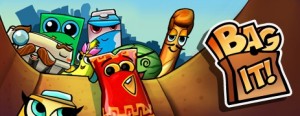 Let’s start off by getting to know a little about the Hidden Variable team. What were some of the games your members worked on before forming the studio, and how did you all happen to meet up? How’s indie life treating you so far?
Let’s start off by getting to know a little about the Hidden Variable team. What were some of the games your members worked on before forming the studio, and how did you all happen to meet up? How’s indie life treating you so far?
We have a pretty eclectic background. Members of our team have worked on titles ranging from The Sims 2 to Rise of the Argonauts to Desperate Housewives. We basically met up at our last studio, Liquid Entertainment, where we primarily worked on console and Facebook games. We all had different areas of expertise, which served us well due to the sheer amount of different skillsets needed when starting a new business.
We had heard enough horror stories when we embarked on this endeavor to know what we were getting into, but all the planning in the world doesn’t change the fact that you still need to juggle a dozen things at once. Sometimes you want to just sit down and make a game, but you still need to make payroll, organize a marketing plan, or clean the bathroom. Things need to get done and they aren’t always the things you want to do first, but making your own games on your own terms is so rewarding and exhilarating that we wouldn’t trade it for anything.
 Tell us about your creative vision – what kind of games do you want to bring to the mobile audience? In what ways does Bag It! set the mood for your work going forward?
Tell us about your creative vision – what kind of games do you want to bring to the mobile audience? In what ways does Bag It! set the mood for your work going forward?
When I worked on console games, I would tell my parents and relatives about the games I was making, but very rarely did any of them actually get a chance to play them. My mom didn’t sit down in front of a PlayStation or Xbox, but she does have an iPhone and iPad. This is one of the big game-changers with mobile devices — the sheer reach of games to impact newer and larger audiences. We can now engage a whole group of people that we never would have been able to reach otherwise.
When we set down to make our first game, we wanted to find the fantastic in the everyday world, something that anyone could see and say, “Wow, I never thought about this in that way.” Bagging groceries is something that virtually everyone is familiar with, whether they had a job doing it or have tried their hand at it when they go to the supermarket. That was the kind of combination we were hoping for, a larger audience and a very familiar, accessible subject. Now, the only thing left to do was make a fantastic game that explored that in a unique and interesting way. Easier said than done!
 You’ve mentioned on your site that Hidden Variable Studios is also available for contract work. What do you look for in a potential partner, and what qualities will a serious project proposal have?
You’ve mentioned on your site that Hidden Variable Studios is also available for contract work. What do you look for in a potential partner, and what qualities will a serious project proposal have?
First and foremost, we’re looking to create quality-focused games around ideas, concepts, or IP that we would be proud to work on. Games take an incredible amount of time, energy, and effort to make, and it would be doing everyone on the team a disservice to take on an otherwise unexciting project purely for financial reward. Don’t get me wrong, money is great and it allows you other opportunities, but we started the studio to develop games that leave a lasting impression and we would never want to compromise that. Now of course, working with a third party often allows you to do things you normally couldn’t, such as working with a particularly cool license that you wouldn’t otherwise have the rights to. That said, before we accepted a contract, we would want to make sure that the final product would fundamentally fit with our goals and sensibilities as a studio.
I love to joke about the crazy things iOS games have players doing, and I think a grocery packing puzzle game *might* just be one of the few ideas that hasn’t been fully explored yet. Can you tell us any interesting stories about how the team came up with this idea for a videogame?
Our Chief Creative Officer, Charley Price, is always talking about finding the wonderful in the mundane. He tells a story about a couple of kids in an airport who are bored because their parents are arguing. These kids start making up games to entertain themselves, flying around the airport with their arms outstretched or building a fort out of luggage. It is this child-like quality that we are trying to capture. This is something essential we have buried deep inside of us, and our goal is to bring this out in everyone through our games.
Just walking through the aisles of a supermarket, you see all these crazy, disparate products and you can just see something wild in this environment. Many of these products have colors and characters and slogans that make you just stop and think. What better than to bring these characters to life and turn it into something that only a child could imagine?
 Interestingly, Bag It! has been available in New Zealand, Australia, and Canada already for some time, hasn’t it? And the US and UK are just now getting it this month on the 17th? What advantages does this kind of release strategy bring for you? Any potential pitfalls other devs might want to be aware of in case they want to try it, for that matter?
Interestingly, Bag It! has been available in New Zealand, Australia, and Canada already for some time, hasn’t it? And the US and UK are just now getting it this month on the 17th? What advantages does this kind of release strategy bring for you? Any potential pitfalls other devs might want to be aware of in case they want to try it, for that matter?
We called our initial launch in New Zealand, Australia, and Canada our “soft launch.” The goal was to test our games with real, objective people and see what they thought. We had a lot of our friends and family play the game, but despite all our pleadings, they are never really as brutally honest as someone you don’t know who has actually paid money for your product. By going through the process of launching and getting feedback, we could iron out the wrinkles in the game when we released to the rest of the world.
We still feel the idea was fundamentally sound, but there are some drawbacks to doing it that way. One major issue is discoverability. You still want to “save up” your marketing efforts for your eventual worldwide release but it’s difficult to get people in these ancillary markets to notice if you don’t do anything. Our hope was that we’d reach out to a few local outlets, get a couple of mentions via the press, and people would just pick it up and start playing. Unfortunately, we didn’t get as many downloads as we had hoped.
Secondly, by doing it this way, you are essentially forgoing some of that initial “burst.” One of the big things everyone wants to do is explode off the starting line, but when you spread your launch over a period of time, you are essentially dividing that burst, even if only by a fraction. It’s hard to strike a balance between launching in enough places to get actionable feedback and launching in a compressed enough timeframe so all of the territories can build off the initial momentum.
Still, there were a ton of great things we gleaned from that launch. We were really focused on keeping our iOS versions of the game under 20 MB to enable over-the-air downloads. Our final file size looked like it was around 16MB prior to any additional overhead via the final packaging process, but we felt pretty confident that we would be under that 20 MB limit. But when we finally launched, lo and behold — 21.8 MB! As such, over the next week we immediately dove into some optimizations and ultimately resolved the issue. That said, if that had occurred during our “hard launch” when all of our press had gone live, that could have dramatically reduced our actual sales. For that reason alone, the “soft launch” process was definitely worth the investment.


